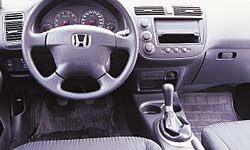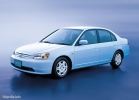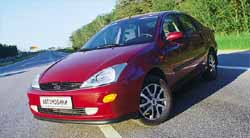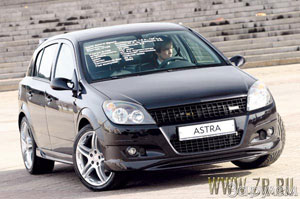Test drive Honda Civic sedan 2000 - 2003 sedan
The magic of numbers
 Since ancient times, many peoples revere seven as a symbol of perfection and harmony. The number three are performed no less deep meaning. On the eve of the third millennium, the seventh generation of Honda Civic appears.
Since ancient times, many peoples revere seven as a symbol of perfection and harmony. The number three are performed no less deep meaning. On the eve of the third millennium, the seventh generation of Honda Civic appears. Civic first appeared in the 70s, more precisely-in 1972. For the entire production time, 7 million cars were sold twice. The engine volume of the new sedan is 1.6 liters, which is again seven in total. And finally, the official premiere of this car in Russia took place on November 17. These are such funny coincidences.
 The third position. The appearance, it seems, is quite perfect and harmonious. However, a profile with a dome -shaped roof, very gentle wind and rear windows, wide rear racks integrated into the corners of the external optics blocks, a short, cool hood with a short front overhang and an almost vertical cut of a bumper, an acute angle of the trunk edge - all this causes analogies with samples of other world car manufacturers. However, the mutual overexposals of design solutions were, are and will be. More important than another. Compared to his predecessor, the new Civic matured and changed the tracksuit with a tie with a tie. A solidity element appeared in it, according to external data, it is no longer a mass machine, although not a business class-something third, intermediate.
The third position. The appearance, it seems, is quite perfect and harmonious. However, a profile with a dome -shaped roof, very gentle wind and rear windows, wide rear racks integrated into the corners of the external optics blocks, a short, cool hood with a short front overhang and an almost vertical cut of a bumper, an acute angle of the trunk edge - all this causes analogies with samples of other world car manufacturers. However, the mutual overexposals of design solutions were, are and will be. More important than another. Compared to his predecessor, the new Civic matured and changed the tracksuit with a tie with a tie. A solidity element appeared in it, according to external data, it is no longer a mass machine, although not a business class-something third, intermediate.  To measure seven times. Creating a new Civic, Honda engineers went against the laws of the genre and began the construction of the car from the inside. The body was put on the salon, and not vice versa. As a result, the salon of the new Civic turned out to be almost the most spacious in its class. The disadvantages inherent in the predecessor - a low ceiling and narrow seats - are completely eliminated. In the shoulders area, the salon was noticeably width, and the front seats became wider. Now they are equipped with a vertical adjustment in standard configuration, and it is not difficult to choose the most convenient position even in the version with a hatch, which usually eats a lot of space over your head.
To measure seven times. Creating a new Civic, Honda engineers went against the laws of the genre and began the construction of the car from the inside. The body was put on the salon, and not vice versa. As a result, the salon of the new Civic turned out to be almost the most spacious in its class. The disadvantages inherent in the predecessor - a low ceiling and narrow seats - are completely eliminated. In the shoulders area, the salon was noticeably width, and the front seats became wider. Now they are equipped with a vertical adjustment in standard configuration, and it is not difficult to choose the most convenient position even in the version with a hatch, which usually eats a lot of space over your head. Changes in the component of the salon should evaluate those who have to travel on the gallery-with completely moved away the front seats there will be almost the same as the same as in the business class sedans. This was also facilitated by the application of decisions running on CR-V and H-RV and allowed to make the floor of the cabin completely flat, without a traditional longitudinal tunnel in the middle. The volume of the trunk increased by 60 liters, and the ability to fold the back of the rear seat in parts will add even more space.
 The interior design has almost not changed, and the standard package of sedan’s offers offered in the Russian market includes two airbags, an electric drive of all glasses and a heating mirror, air conditioning, immobilizer and a central remote control. The version more expensive implies a climatic installation, heating of the seats, an electric hatch and two side airbags, instead of air conditioning.
The interior design has almost not changed, and the standard package of sedan’s offers offered in the Russian market includes two airbags, an electric drive of all glasses and a heating mirror, air conditioning, immobilizer and a central remote control. The version more expensive implies a climatic installation, heating of the seats, an electric hatch and two side airbags, instead of air conditioning. One hundred to one. The engine underwent indigenous revision. And, in our opinion, it would be more correct to consider it as an option to modernize the 116-horsepower 1.5 VTEC than a 160-horsepower 1.6-liter
 VTI. Having received an additional one hundred grams of volume, the intake manifold of the new configuration, nozzles with four holes in each, the crankshaft of reduced mass, new pistons and software, he radically changed his characteristics. The maximum torque increased by 18 nm, and its highest value is achieved on quite real 4300 rpm. Against 5600 in the previous 1.5-liter engine. Powerful and flat thrust occurs from the bottom and lasts almost to the red zone of the tachometer. In a sense, Civic lost his previously nervous character, but the task was in order to align the characteristics of the moment.
VTI. Having received an additional one hundred grams of volume, the intake manifold of the new configuration, nozzles with four holes in each, the crankshaft of reduced mass, new pistons and software, he radically changed his characteristics. The maximum torque increased by 18 nm, and its highest value is achieved on quite real 4300 rpm. Against 5600 in the previous 1.5-liter engine. Powerful and flat thrust occurs from the bottom and lasts almost to the red zone of the tachometer. In a sense, Civic lost his previously nervous character, but the task was in order to align the characteristics of the moment. The motor is amazingly elastic, which is extremely convenient in the city, in the mode of constantly alternating accelerations, and on the highway. If you move in the general stream rhythm, in most cases you can cost a very universal fourth gear. The speed can fall to about 30 km/h, and the speed will slightly exceed a thousandth mark, but it is enough to literally literally stroke the gas pedal and the car slowly but smoothly begins to gain speed. And on
 the high gear highway will completely reset the speed of kilometers up to 35-40 and again calmly dial it. And if the arrow of the tachometer crossed the 3,000th mark, then even in the highest gear and at a speed of more than 100 km/h to press the accelerator, the car responds with a noticeable pickup. The machine is also very good: everything is fine with reactions. That is, some delay is present, but it is minimal, and to a sharp pressure, the machine reacts with a distinct pickup, accompanied even by something similar to squatting and intense acceleration. Moreover, not in every case, the machine switches to the transmission below. Those who expect from this new Honda athletic manifestations of a sports nature, of course, the mechanic is more suitable, but the machine is not far behind here.
the high gear highway will completely reset the speed of kilometers up to 35-40 and again calmly dial it. And if the arrow of the tachometer crossed the 3,000th mark, then even in the highest gear and at a speed of more than 100 km/h to press the accelerator, the car responds with a noticeable pickup. The machine is also very good: everything is fine with reactions. That is, some delay is present, but it is minimal, and to a sharp pressure, the machine reacts with a distinct pickup, accompanied even by something similar to squatting and intense acceleration. Moreover, not in every case, the machine switches to the transmission below. Those who expect from this new Honda athletic manifestations of a sports nature, of course, the mechanic is more suitable, but the machine is not far behind here. Angular value. Honda engineers worked on the suspension even more thoroughly than over the engine. The front is MacPherson, but not ordinary: it is equipped with a system for controlling the convergence angles in order to keep these angles in the specified framework with constant fluctuations in the wheel up and down. And this is, first of all, exchange rate stability, stable connection with the road and controllability, counteraction to the departure into lateral sliding, simply put, in the ski.
 The rear suspension is double -leafed, with transverse thrust and elastokinematic couplings. And her main highlight is not even in the steaming effect, which is especially noticeable if at the exit from a 90-degree turn you carefully add gas. The main advantage is that the angle of convergence of the rear wheels can change under the influence of lateral forces in various situations and withstand the departure into lateral sliding. And at the moment of sharp braking, the back suspension, as it were, moves back, the angle of convergence of the wheels increases, due to which a stable rectilinear position of the car on the road is achieved.
The rear suspension is double -leafed, with transverse thrust and elastokinematic couplings. And her main highlight is not even in the steaming effect, which is especially noticeable if at the exit from a 90-degree turn you carefully add gas. The main advantage is that the angle of convergence of the rear wheels can change under the influence of lateral forces in various situations and withstand the departure into lateral sliding. And at the moment of sharp braking, the back suspension, as it were, moves back, the angle of convergence of the wheels increases, due to which a stable rectilinear position of the car on the road is achieved. How does all this work in practice? Wonderful. On a bunch of good steep turns, we provocatively press on gas. At some point, Civic succumbs and begins to shift out. But it does not happen exactly as in front -wheel drive machines with an ordinary rear suspension, but evenly, both axes, while the situation remains completely under control. And here I was writing off the rubber, we correctly adjust the gas and the steering wheel-the machine obediently screws into the turn. A car with a conventional suspension would have begun to slide for a long time!
The cars that have been in our hands are from the very first serial party collected at the factory in Suzuk, and therefore we will express the assumption that Honda’s speakers still have something to work on. The new Civic finds a strange low -frequency noise, which, as it were, concentrates in the trunk area and clearly auditions at any speed, age as it increases. It is not very strong, but annoying. Maybe this is the fault of the hard summer highway rubber and the low temperature overboard? A good audio system will not hurt the first owners.
Text Andrey Timofeev, photo Alexey Ilyin.
Source: "Autopilot"
Honda Civic Crash Test Video Sedan 2000 - 2003
Honda Civic Sedan 2000 test drives - 2003
Honda Civic Crash Test Sedan 2000 - 2003
Krassh Test: Detailed Information27%
Driver and passengers
26%
Pedestrians











